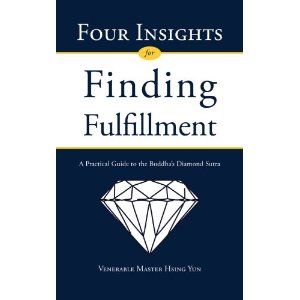I sit at one of Hsing Yun’s temples, on Park in San Diego. One afternoon, I walked into their bookstore, having read earlier in the day some of Huineng’s commentary on the Diamond Sutra, and what stared out at me but this? I couldn’t help but, contrary to habit, buy the thing. Just finished it.
I read a post a bit back on another blog, reviewing in a way the book, Democracy’s Dharma. The author noted:
generally Madsen shows the Taiwanese organizations breaking down along occupational and socioeconomic lines: Tzu Chi for service workers, Fo Guang Shan [Master Hsing Yun‘s organization] for managers and entrepreneurs, and Dharma Drum for artists and academics.
Dharma Drum is my lineage, but living as I do in San Diego I sit at a Fo Guang Shan temple, so how I understand Four Insights for Finding Fulfillment is conditioned by my experience in the two places. So, I will say that it’s my own issue that my first feeling when going through the book was that this was a very expedient means: lots of discussion of very practical concerns the likes of which I would imagine businesspeople (precisely as the quote above intimated) would have, followed by practical advice, reference to anecdote, and a quote with citation from the Diamond Sutra. The Sutra itself is an appendix.
They call us practitioners for a reason, because I certainly haven’t got this ego thing worked out. I will say that what I felt at first in the book was skimming the surface–no discussions about unmediated mind, the nature of mind and phenomena, etc.–built as the book progressed. The quotes from the Sutra became longer, and the discussions of the substance of the Dharma became lengthier, on their own terms rather than in reference to typical situations one encounters in what we imagine to be real life. Master Hsing Yun takes a different tack than Sheng Yen did, but he is absolutely dealing with the same thing.
I am at a point now where I have enough confidence in myself to actually make a point about how Buddhism goes down in North America. I have not lived in the same town as my Dharma teacher for many years now, and though I listen to his talks via the internet, I have also looked for instruction where I am. Face to face is good. So, I’ve stumbled into a lot of stuff on my way.
Here’s the point: a bunch of upwardly-mobile young white people started practicing with these amazing Asian teachers, and then, in the name of expedient means, started teaching all kinds of stuff in the name of the Dharma while completely losing the plot. I’ll put forward that there’s a lot of underlying white nonsense happening: we will drop the archaic Asian superstition and have a Buddhism for the “West.” This is Orientalism at work.
Master Sheng Yen and Gilbert, my teacher–as well as all kinds of other people, like Master Hsing Yun–employ expedient means, but they put the real point
There is no suffering, no cause of suffering
No cessation of suffering, and no path.
in their talks and books.
I am pleased that at this point I can distinguish shit from Shinola.
There I am, with my teacher. So:
- You can talk about psychology in your Dharma, but only if you use it as a door to Ch’an, or Zen, or whatever you call it.
- You can incorporate martial arts into your program, but only if there’s a point where you drop the fighting and experience non-duality.
- You can tell someone that practicing can help their recovery, but only if you’ll help that person get to the point where their recovery is there to help their practice.
- Last, Buddhism is not a brand.
An accomplished practitioner here who facilitates a sitting group I attend told me, when I pointed out some of these concerns that he couldn’t see how the Dharma was the Dharma if there wasn’t any satori in it. He comes from a Japanese lineage but the point is obvious. Sheng Yen tossed you in the deep end fairly quickly, and Hsing Yun and Thich Nhat Hanh take different tacks, but in all three they put it all on the table so the people who are ready for it can go. That I can work with.



